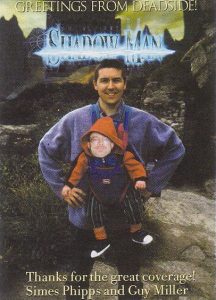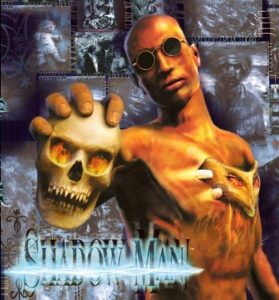These two Spanish-language interviews from 2000 promoted the release of the Dreamcast version of the Shadowman game. The first interview appeared in the January issue of Revista Oficial Dreamcast and featured Acclaim Studios Teesside Senior Designer Simon Phipps, who joined Acclaim in 1995 as a designer/planner after more than seven years as Core Design, where he had been a founding member. His first project was the hit basketball title College Slam, which he followed with Shadowman, a concept that arose after Acclaim’s main office asked the studio to produce an original 3D horror adventure, “something along the lines of Capcom’s Resident Evil but in full 3D,” based on the company’s recently acquired comics line, Valiant. Several titles were contenders, including Ninjak and Bloodshot, but Shadowman was ultimately chosen. The game’s titular character was a zombie assassin who could take the souls of his victims and travel to the afterlife known as the “Darkside.”
Shadowman was released in September 1999 for the PlayStation, Nintendo 64, SEGA Dreamcast, and PC.
Taking advantage of Shadowman’s arrival on our consoles, we contacted Simon Phipps, one of the “fathers of the creature.” This is what he told us:
Revista Oficial Dreamcast: Given the success of Shadowman on other platforms, and considering that there isn’t another adventure like it on the Dreamcast, what do you expect from this version?
Simon Phipps: Simply, I hope that anyone who plays Shadowman has fun. To me, how many copies a game sells is not as important as it is that those who buy it with the money they saved through effort feel that they have bought something valuable and that it has been worth it (we all know that some of the worst video games ever made have sold thousands and thousands of copies thanks to a license or for other reasons…). I want to believe that the most important thing is quality, especially for those who have bet on the Dreamcast and now have to make a difficult choice when buying their first games.
Revista Oficial Dreamcast: Some of our readers may not know the story of Shadowman. Can you present our hero?
Simon Phipps: It’s simple. Mike Leroy, a college student, becomes Shadowman at night and goes to the Darkside, which is where everyone goes when they die, everyone without exception, including serial killers and the most evil of people. What gives Mike his power is the Mask of Shadows, a powerful voodoo mask that was implanted into his chest by Nettie, a voodoo priest. This means that Mike is under the priest’s control and follows his commands in both our world and the Darkside. The game begins when Nettie starts to dream with serial killers and horrible things happen in the Darkside, things that could result in the end of the world. Mike has to investigate…
 Revista Oficial Dreamcast: Some aspects, like the textures and lighting effects, are better than ever. What other things have been improved in the game? What differences have you found programming the Dreamcast version compared to the other consoles or even the PC?
Revista Oficial Dreamcast: Some aspects, like the textures and lighting effects, are better than ever. What other things have been improved in the game? What differences have you found programming the Dreamcast version compared to the other consoles or even the PC?
Simon Phipps: The most important difference we’ve found is in the great color processing, and everything is richer and brighter than in any other version. Regarding programming, we haven’t had any major problems; we have a technical team full of talent that had to do it. They got down to it… and they succeeded.
Revista Oficial Dreamcast: Did you use the same graphics engine? Are the stages the same as in the other versions?
Simon Phipps: The Dreamcast version is practically the same as the PC one, so there is much more in it than what was in the versions for other consoles.
Revista Oficial Dreamcast: Can we conclude that this is the best version of them all?
Simon Phipps: I like to say so. Shadowman on Dreamcast offers the same experience as on PC but it also is the best-looking version graphically. It also has a decent control scheme in place of the hateful keyboard.
Revista Oficial Dreamcast: And to conclude, are you planning any new games for Dreamcast? We mean a title designed specifically for the Dreamcast, perhaps some secret project that you’d like to reveal?
Simon Phipps: I’ll only say that we’re currently working on the second part of Shadowman, but I don’t yet know if it will have a Dreamcast version.
* * *
This second interview with Guy Miller was featured in the February 2000 issue of DC Magazine. Miller arrived at Acclaim after great success as the as the Creative Manager at Core Design, where he was involved with the Tomb Raider franchise, and earlier as the Director of Creative Design at Rare, where he was one of the minds behind the classic Battletoads. Miller arrived at Acclaim in 1995 and served as the Creative Director on Shadowman.
Guy Miller’s reputation precedes him. “Oh, you’re going to meet a serial killer,” one writer commented. “Don’t let him take off his mask.” Strange, but sure, if you think Shadowman is normal than such a reputation suits you. There’s nothing like a game with a killer who makes you read The Exorcist every night to calm yourself before bed. Of course, shaving your head and lighting yourself on fire during the game’s presentation are also elements to bear in mind in this story. But then you meet him and he’s a calm fellow who’s soft-spoken, about whom you come to think that his reputation is excessive and undeserved. Ah, the quiet ones are always the worst.
DC Magazine: What did you do before you worked in video games?
Guy Miller: I graduated in art and then was an actor, a bartender, and a box designer for Mark’s & Spencer. Then I became a freelance designer. One day, I saw an ad for Rare and thought they made cards.
DC Magazine: They were already known then?
Guy Miller: They were about fifteen people. They just sold Ultimate Play. I arrived with a book based on cards and exasperated them. Later I became their head of the creative design area.
DC Magazine: What was it like to design for Core after Rare?
Guy Miller: Refreshing. Rare only works on products in Nintendo’s style. Core, on the other hand, works with anything, like Soulhawk or Battlehawk.
DC Magazine: Why did you leave then?
Guy Miller: Simon Phipps (Miller’s creative partner) and I are pretty good at coming up with ideas and immediately working with them. We don’t do very well with following what goes on and what we’re asked to do. So, we had to find a new, pressure-free environment.
DC Magazine: And how is that reflected in Shadowman?
Guy Miller: I want to explore the narrative aspect of this kind of action and adventure game more. I don’t think we’ve found the right language yet, and that’s Hollywood’s fault because people have an idea about how these movies should go. There should be a western style. Well, then there’s the Japanese B-movie style stuff, something everyone respects. Not me; I think they’re horrible. In fact, if they were English or American no one would be interested.
DC Magazine: Is there any similarity between you and Mike LeRoi, the hero of Shadowman?
Guy Miller: Only in the concept art. Everyone said that he looked like me because he was bald and used the same sunglasses, but at Core I worked on Lara Croft and I identified a lot with her.
DC Magazine: There are a lot of people who say they’ve worked on Lara Croft or even invented her.
 Guy Miller: [Laughs]. Yes, that’s true. It was actually Toby Gard who created her. My contribution was that I named her Lara. I wanted her to be called Lara Cruise, but Toby wanted her name to be totally English.
Guy Miller: [Laughs]. Yes, that’s true. It was actually Toby Gard who created her. My contribution was that I named her Lara. I wanted her to be called Lara Cruise, but Toby wanted her name to be totally English.
DC Magazine: Have you always liked horror?
Guy Miller: Yes, I’ve always loved Stephen King and Clive Barker. I’d love to do something along those lines in video games.
DC Magazine: Will people want to do horribly nasty and realistic things as graphics get better?
Guy Miller: We need a moral center. The concept of morality has been turned upside down since the murder films of the seventies: sex is bad and if a teenager does it he must die. Something has to be done about all this.
DC Magazine: What would you do if you weren’t in video games?
Guy Miller: Paint. I just had an exposition in Oxford. Also, I’ve written a novel and a screenplay for television and another for movies.
DC Magazine: Where do you get so much energy?
Guy Miller: Well, I don’t know. Perhaps it is Thanatos[the Greek personification of death], the mortal instinct (as Freud described it). Anyway, maybe I’m being a bit premature, since I’m only 38 years old. Horror, however, is closely related to death – the fear of death, in any of its forms.

Recent Comments